Saturn reaches opposition this week, offering the best view of it we've had in years. This guide will help you explore the ringed planet's many charms.
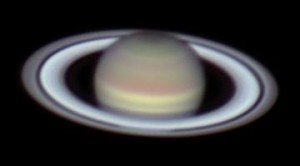
Efrain Morales
"That doesn't look real."
"I've never seen anything like it."
"Wowwwww ...!"
Sound familiar? Then you must have shown somebody Saturn through a telescope. Or maybe one of those describes your reaction at seeing the ringed planet for the first time.
Sharing Saturn with the public is one of the joys of being an amateur astronomer. It reminds us of the wonder factor that makes astronomy a popular and accessible science.
Friday evening, May 22nd, Saturn reaches opposition, when it's closest to Earth for the year. Oppositions always feel like Christmas. Amateurs anticipate the time when planets are closest because they're also biggest and brightest. Like a kid lunging for that gift under the Christmas tree, we're eager to point our telescopes at Saturn at every opportunity this season.
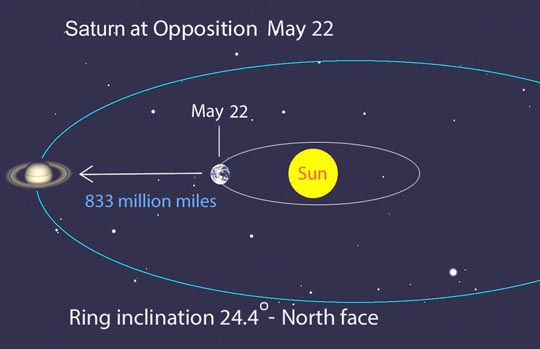
Bob King
Saturn rises around sunset Friday night in the constellation Libra, crossing the meridian around 1 a.m. daylight time Saturday and setting near sunrise. With its icy rings tipped nearly wide open, the ring king shines at magnitude 0.0, its brightest in more than 8 years.
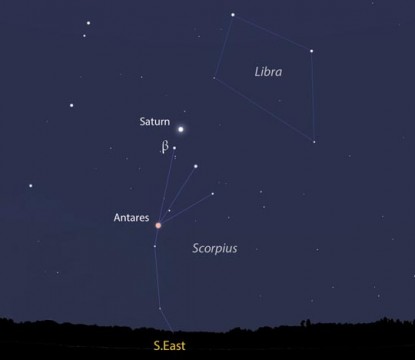
Stellarium
Saturn's in good company these nights. The beautiful, small-scope double star, Beta Scorpii, gleams just 2° to its southeast, while radiant Antares, Scorpius' brightest star, adds a touch of ruddy warmth 10° farther down the sky.
Learn everything there is to know on Saturn with Sky & Telescope's FREE Saturn ebook. Delve into this ringworld, learn about its weird, icy moons, and find out whether we'll ever find life on Titan.
Cloud Belts
Through a telescope, Saturn's globe's the color of a latte, while the rings, primarily composed of water ice, are more reflective and appear noticeably whiter. The planet's cloud belts have a lower contrast than Jupiter's in part because they're topped by a deep layer of haze.
On an average night you might see only one — the North Equatorial Belt (NEB) bordering the pale Equatorial Zone — but when the air is steady and Saturn presents a crisp image at 200× and higher, look for an additional belt or two parallel to the NEB as well as the darker, button-like North Polar Region.
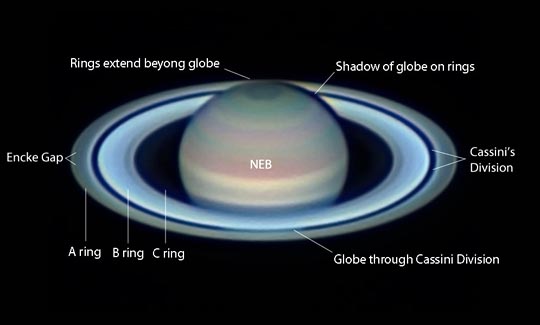
Brian Combs
Ring Divisions
Saturn's rings have real eye appeal while also offering all manner of challenges to the telescopic observer. Since the ring plane is tipped nearly wide open, Saturn's most famous ring gap, Cassini's Division, is easy to see in even a small scope. Incredible to think it's just 0.75″ wide, well below the double star resolution limit for a 3-inch telescope. And yet, on a night of good seeing, the rift is plain to see.
The resolving power of a telescope is most always given in relation to separating double stars. But for an isolated detail like Cassini's Division in a high contrast setting (dark gap vs. bright rings), we can do much better.
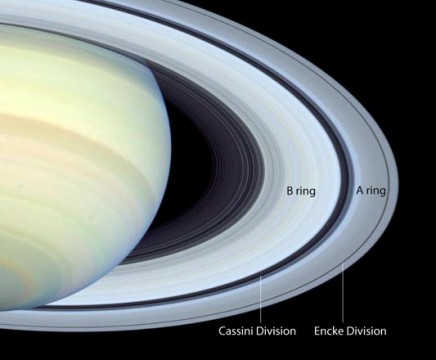
NASA / ESA / E. Karkoschka (Univ. of Arizona)
If you have a 12-inch or larger scope and can effectively use 400x or higher, seek out the much more challenging Encke's Division. Measuring just 0.05″ wide, this slimmest of gaps separates the outer A ring from the inner. It's best visible where it appears widest, at the very ends of the rings.
Hide and Peek
Many of us may never see Encke's, but there are plenty of other equally interesting — yet more achievable — challenges. Can you follow the arc of the ring plane atop Saturn's globe? What about the venetian-blind view of the globe peeking through Cassini's gap? Pay attention to the shadings of each of the rings. B is brightest, A looks grayer, and C is dim and translucent. A 6-inch scope should show all three.
Saturn's globe also casts a curved shadow on the ring plane that gives the planet a striking 3D appearance. Around opposition, it's partially hidden behind the globe and tricky to see. As the season progresses, the shadow will gradually fall to the east and stand out better.
Moons and More Moons
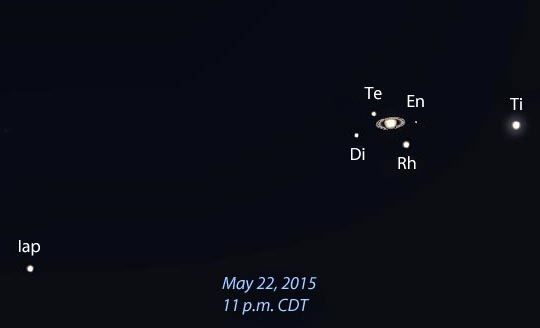
Stellarium
Saturn displays at least five moons in a 6-inch telescope, more than any other planet, ranging from easy peasy Titan at magnitude 9 to Dione at 11. Iapetus varies from magnitude 10.2 near western elongation to 11.9 around eastern elongation. Like Jupiter's satellites, Saturn's are a lot of fun to watch. Lucky for us, Iapetus's western elongation (brightest appearance) coincides with opposition this year. The maps will help you keep track of it.
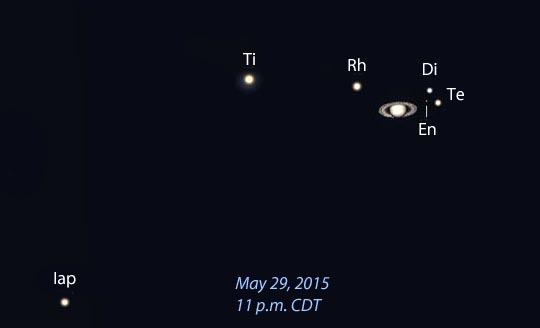
Stellarium
An 8-inch scope will nab closer-in Enceladus, but you'll need a 12-inch or larger scope to find faint Mimas, nearly lost in the "enhanced" glare from Saturn's rings, and distant 14th-magnitude Hyperion. Use Sky & Telescope's handy Saturn's Moons calculator to locate five of the brightest moons any time of night or year. Software programs like Stellarium (free), Guide, Starry Night, SkyMap and others will help you track down the tougher ones.
Opposition Surge
No survey of Saturnian delights would be complete with a mention of the Seeliger Effect. For a few days around opposition, Saturn's rings become considerably brighter than the globe.
In April 2013, amateur astronomer Richard Keen of Coal Creek Canyon, Colorado, described the effect through his 12.5-inch telescope:
“The rings were markedly brighter than the ball of the planet, while usually they’re about the same brightness. The contrast lines between where ball of the planet hides the far side ring, and between the near side ring and the planet, were sharper, too."

Christopher Go
Two key factors contribute to the brightening, the first called the "opposition effect." When we face with our backs to the Sun, objects in front of us are squarely lit by sunshine streaming over our shoulders. Any shadows cast by rocks, bumps, or irregularities are hidden directly behind the objects. Without shadows to "darken" the scene, the view directly in front of us peaks in light intensity.
Something similar happens when we look at Saturn’s rings during the days leading up to and after opposition. The Sun streams past the Earth (our shoulders) and shines directly onto the ring particles. With their shadows temporarily hidden, the rings surge in brightness.
While “shadow hiding” is an important reason for these surges, the phenomenon of coherent backscatter also plays a role in the Moon, Saturn’s rings, and other planets and asteroids with rocky, dusty surfaces. When a light source shines at a very direct angle on material made of a multitude of tiny, dust-like particles, multiple reflections combine to produce a single brighter reflection directly back at the observer.
If you don't do astrophotography, mentally compare the brightness of Saturn's rings to the globe within a few days of opposition, then return a few weeks later to compare.
About the only downside of Saturn observing for skywatchers at mid-northern latitudes is the planet's low elevation and susceptibility to poor seeing. Hang in there. If you check at every clear opportunity, you're bound to catch a great night. Warmer weather makes it easy to be outside, too. As long as you're out, invite your friends and neighbors for a look, too. Their wonder will be your pleasure.
New to the night sky? Check out the Sky & Telescope Beginning Stargazer's Kit!
 0
0
Comments
You must be logged in to post a comment.